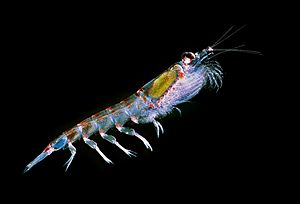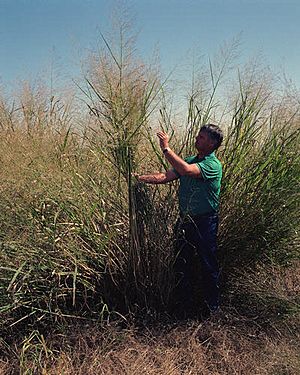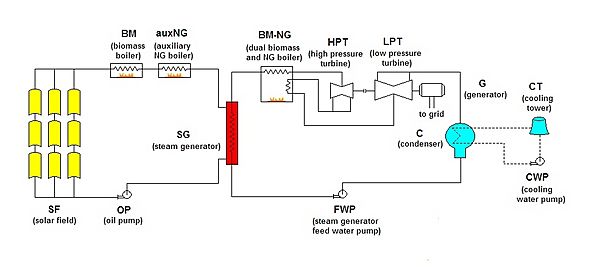Biomass facts for kids
Biomass is a basic term in ecology, and in the energy production industry. Organic waste such as dead plant and animal material, animal dung and kitchen waste can be converted into gaseous fuel called biogas. The organic waste is decomposed by bacteria in biogas digesters to emit biogas which is essentially a mixture of methane and carbon dioxide.
In ecology, biomass means the accumulation of living matter. It is the total living material in a given area or a biological community or group. Biomass is measured by weight, or by dry weight, per given area (per square metre or square kilometer). In the energy industry, it refers to biological material which can be used as fuel or for industrial production. Biomass includes plant matter grown for use as biofuel, and also includes plant or animal matter used for production of fibres, chemicals or heat. Biomass may also include biodegradable wastes which can be burnt as fuel. It excludes organic material which has been transformed by geological processes into substances such as coal or petroleum. It is usually measured by dry weight.
Energy industry
The term biomass is especially useful for plants, where some internal structures may not always be considered living tissue, such as the wood (secondary xylem) of a tree.
Biofuels include bioethanol, biodiesel & biogas.
Biomass is grown from several plants, including switchgrass, hemp, corn, poplar, willow and sugarcane. The particular plant used is usually not very important to the end products, but it does affect the processing of the raw material. Though biomass is a renewable fuel, its use can still contribute to global warming. This happens when the natural carbon equilibrium is disturbed; for example by deforestation or urbanization of green sites.
Biomass is part of the carbon cycle. Photosynthesis converts carbon from the atmosphere into plant matter. When the plant rots or burns, the carbon goes back into the atmosphere. This happens somewhat quickly, and plant matter used as a fuel can be constantly replaced by planting for new growth. Therefore, it doesn't much change the amount of atmospheric carbon.
Although fossil fuels come from things that died long ago, they are not considered biomass by the generally accepted definition because they contain carbon that has been 'out' of the carbon cycle for a very long time. Burning them combustion therefore adds much carbon dioxide to the atmosphere.
Other uses of biomass, besides fuel:
- Building material
- Paper (using cellulose fibres)
- Biodegradable plastics
Plastics from biomass, like some made to dissolve in seawater, are made the same way as petroleum-based plastics, are actually cheaper to manufacture and meet or exceed most performance standards. But they lack the water resistance of conventional plastics.
Ecology
The most successful animal, in terms of biomass, is the Antarctic krill, Euphausia superba, with a biomass of probably over 500 million tons across the world, about twice the total biomass of humans. Biomass may also be a measure of the dried organic mass of an ecosystem.
This is a summary of biomass data.
| BIOME ECOSYSTEM TYPE | Area | Mean Net Primary Production | World Primary Production | Mean biomass | World biomass | Minimum replacement rate |
|---|---|---|---|---|---|---|
| (million km²) | (gram dryC/sq metre/year) | (billion tonnes/year) | (kg dryC/sq metre) | (billion tonnes) | (years) | |
| Tropical rain forest | 17.0 | 2,200 | 37.40 | 45.00 | 765.00 | 20.45 |
| Tropical monsoon forest | 7.5 | 1,600 | 12.00 | 35.00 | 262.50 | 21.88 |
| Temperate evergreen forest | 5.0 | 1,320 | 6.60 | 35.00 | 175.00 | 26.52 |
| Temperate deciduous forest | 7.0 | 1,200 | 8.40 | 30.00 | 210.00 | 25.00 |
| Boreal forest | 12.0 | 800 | 9.60 | 20.00 | 240.00 | 25.00 |
| Mediterranean open forest | 2.8 | 750 | 2.10 | 18.00 | 50.40 | 24.00 |
| Woodland and shrubland | 5.7 | 700 | 3.99 | 6.00 | 34.20 | 8.57 |
| Savanna | 15.0 | 900 | 13.50 | 4.00 | 60.00 | 4.44 |
| Temperate grassland | 9.0 | 600 | 5.40 | 1.60 | 14.40 | 2.67 |
| Tundra and alpine climate | 8.0 | 140 | 1.12 | 0.60 | 4.80 | 4.29 |
| Desert and semidesert scrub | 18.0 | 90 | 1.62 | 0.70 | 12.60 | 7.78 |
| Extreme desert, rock desert, sand or ice sheets | 24.0 | 3 | 0.07 | 0.02 | 0.48 | 6.67 |
| Cultivated land | 14.0 | 650 | 9.10 | 1.00 | 14.00 | 1.54 |
| Swamp and marsh | 2.0 | 2,000 | 4.00 | 15.00 | 30.00 | 7.50 |
| Lakes and streams | 2.0 | 250 | 0.50 | 0.02 | 0.04 | 0.08 |
| Total continental | 149.00 | 774.51 | 115.40 | 12.57 | 1,873.42 | 16.23 |
| Open ocean | 332.00 | 125.00 | 41.50 | 0.003 | 1.00 | 0.02 |
| Upwelling zones | 0.40 | 500.00 | 0.20 | 0.020 | 0.01 | 0.04 |
| Continental shelf | 26.60 | 360.00 | 9.58 | 0.010 | 0.27 | 0.03 |
| Algal beds and reefs | 0.60 | 2,500.00 | 1.50 | 2.000 | 1.20 | 0.80 |
| Estuaries & mangroves | 1.40 | 1,500.00 | 2.10 | 1.000 | 1.40 | 0.67 |
| Total marine | 361.00 | 152.01 | 54.88 | 0.01 | 3.87 | 0.07 |
| Grand total | 510.00 | 333.87 | 170.28 | 3.68 | 1,877.29 | 11.02 |
Related pages
Images for kids
-
System boundaries for carbon accounting: Option 1 (black) limits the carbon calculation to stack emissions, option 2 (green) limits the calculation to the forest carbon stock, option 3 (blue) limits the calculation to forest and stack emissions combined (the supply chain) and option 4 (red ) includes both stack emissions, forest and the bioeconomy (carbon storage in wood products and displaced fossil fuels.)
-
Net emissions from various biofuel pathways (heat production). Stippled lines show net emissions for EU coal, light fuel oil, most relevant fossil fuel alternative, and natural gas. Dotted areas show emission savings percentages compared to the most relevant fossil fuel alternative (white 70–80%, green 80–85%, blue 85–100%.
-
Net emissions from various biofuel pathways (electricity production). Stippled lines show net emissions for EU coal (black), most relevant fossil fuel alternative (green), electricity mix (red) and natural gas (blue). Dotted areas show emission savings percentages compared to the most relevant fossil fuel alternative (white 70–80%, green 80–85%, blue 85–100%.
See also
 In Spanish: Biomasa (energía) para niños
In Spanish: Biomasa (energía) para niños


















